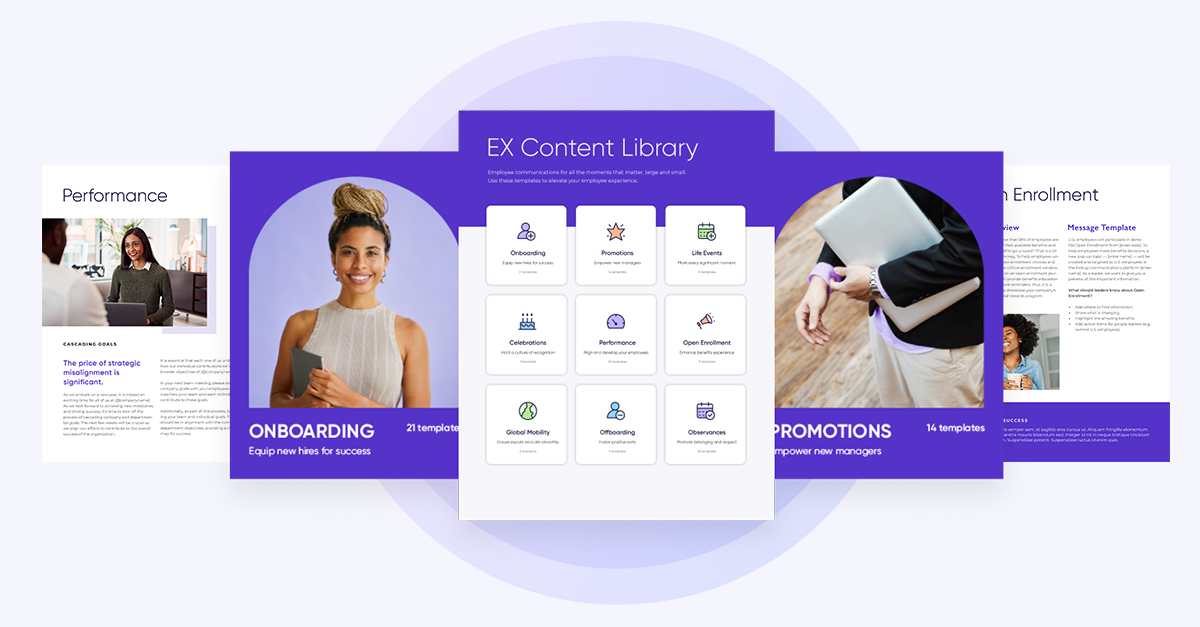As the modern workplace rapidly evolves, CHROs and People Teams are tackling numerous challenges, including recruiting workers with the right skill sets, connecting a dispersed workforce, developing effective managers, and reducing attrition.
Employee engagement is central to achieving these goals. More than ever, HR leaders need the right technology and effective communication strategies to create an exceptional employee experience—while demonstrating ROI on initiatives.
Today’s HR leaders are becoming increasingly strategic to deliver on business outcomes. Here are three key ideas to help you achieve your goals and set your companies up for success.
1. Data is HR’s secret weapon against attrition
Traditional measures of employee sentiment such as quarterly polls, pulse surveys, and exit interviews are no longer sufficient. Employee engagement surveys represent a mere snapshot without enough early warning signals to allow leaders to respond proactively.
Behavioral data reveals employee engagement
HR leaders need real-time insights that take the guesswork out of employee attrition by detecting disengaged employees so they can take action before it’s too late.
Firstup partnered with OneModel, a leading workforce analytics company, to examine the relationship between communication engagement and attrition.
The findings revealed a strong positive correlation between employees’ engagement with internal communications and their likelihood to either stay with the organization or depart. Notably, real-time analytics on low engagement served as a valuable early warning system, often providing signals of potential employee resignation up to three months in advance.
The data also identified specific cohorts so that their managers could step in and find out the reasons for disengagement. Compared to engagement surveys that only evaluate a past period of time, real-time analytics change the game from filling holes in the workforce to preventing losses in the first place.
“Most of the data that we look at is after the fact. By the time you process attrition from the last quarter or last year, months have passed. What we’re looking for is predictive data that helps you change a business outcome moving forward.”
— Evan Wittenberg, Chief People Officer, Pivot Bio
Data makes the case for HR programs
In the ever-evolving landscape of HR and internal communications, leaders are constantly striving to craft employee programs that foster satisfaction and engagement. Initiatives like innovative onboarding campaigns, digital open enrollment, mentorships, career rotation schedules, and educational opportunities are crafted with the goal of enhancing the employee experience.
However, today’s HR leaders find themselves at a crossroads, tasked with not only developing these vital programs but also providing the ROI to various stakeholders, including legal teams, cybersecurity experts, and the C-suite. The key to making a compelling case? It lies in quantifiable data.
“When you can correlate employee engagement to things like turnover and performance, you’ve moved beyond programs and functions to catalysts for improving company performance. That’s how data storytelling completely changes the conversation.”
— Sabra Sciolaro, Chief People Officer, Firstup
To truly appreciate the value of quantifiable data, it’s essential to understand that tracking, analyzing, and acting on predictive analytics empowers HR leaders to proactively address potential issues before they result in talent loss. Real-time engagement data forms the crucial bridge that connects HR campaigns to lasting organizational benefits.
Here’s how harnessing data can change the game:
1. Reducing organizational costs: By tracking engagement and its impact on employee retention and performance, HR teams can pinpoint areas for improvement, effectively reducing costly turnover and absenteeism.
2. Enhancing employee program adoption: Armed with data, HR leaders can tailor programs to meet the specific needs and preferences of their workforce, resulting in higher adoption rates and greater overall satisfaction.
3. Boosting productivity: Quantifiable data reveals patterns in employee engagement and performance. With this insight, HR can fine-tune programs to maximize productivity and efficiency across the organization.
4. Elevating employee satisfaction: Data-driven decisions in HR programs lead to more satisfied and engaged employees, creating a positive feedback loop that benefits both the company and its workforce.
Demonstrating the tangible benefits of HR programs goes beyond mere numbers—it’s about becoming strategic catalysts for improved company performance. By harnessing real-time engagement data and connecting the dots between initiatives and outcomes, we are shaping a brighter future for both employees and organizations.
Webinar: Empowering your workforce
Learn how to leverage HR data for stronger engagement and retention
2. AI is an indispensable tool for HR
Artificial intelligence (AI) is rapidly changing how we work. Like any disruptive technology, AI represents an opportunity to rethink our methods and processes.
Rather than replace people, AI is poised to augment human capabilities, making HR more strategic, data-driven, and personalized. Innovative HR leaders recognize this opportunity to streamline operations and make people teams more effective.
AI enhances HR capabilities
- Communication: AI gives HR teams advanced capabilities to work smarter and more efficiently. ChatGPT and other generative AI technologies can significantly enhance the quality of written communication, ensuring messages resonate with different employee groups and optimizing message personalization. They use natural language processing (NLP) to transform organic thoughts into actionable commands, making interactions more user-friendly and efficient.
- Service delivery: ChatGPT and other AI-driven virtual assistants are redefining employee support by providing immediate, personalized responses to employee inquiries, even outside of regular working hours. These virtual assistants simplify the onboarding process, offering tailored responses and resources to new employees from day one, enhancing their experience. AI also takes over routine tasks, such as sending reminders and announcements to specific employee segments, greatly reducing manual workload.
- Predictive analytics: AI swiftly processes and analyzes large datasets. It excels in tasks like sentiment analysis of open-ended survey responses, identifying trends, and benchmarking data in real-time. Predictive analytics tools within AI enabled platforms allow HR teams to foresee future trends and proactively address issues like employee disengagement. AI utilizes communication engagement data and other factors to pinpoint employees at risk, allowing for customized intervention strategies to improve retention.
In the Firstup platform, for instance, CommunicationAI creates a contextualized view of each individual employee, enabling highly personalized campaigns for boosted engagement and retention. With AI-driven predictive modeling and omnichannel delivery, companies can access real-time data on the employee experience and harness it to reduce attrition.
Read more about how HR can work smarter with AI.
“By augmenting human capabilities, AI can help HR professionals make better decisions, provide better service to employees, and create a more positive work environment.”
— Julie Edmonson, Sr. Manager of Customer Success, Firstup
AI expands HR bandwidth
Nothing can replace true human connection. Rather than replace humans, AI can give us the capacity to be more human—focused on relationships, empathy, and compassion.
By freeing up time, AI can allow HR professionals to focus on what matters most, such as building relationships with employees, developing talent, and creating a positive work culture.
Webinar: Personalizing the employee journey
Learn how to overcome workplace communication challenges to reach every employee
3. Personalization is key to employee engagement
Marketing professionals craft customer experiences that guide buyers from first interaction to ongoing brand loyalty. Successful companies know their customers and engage with them according to their personal preferences throughout the customer journey.
When HR leaders engage workers in similar fashion, they can transform the employee experience.
Treat employees like internal customers
One of the most significant challenges HR leaders currently face is connecting a dispersed workforce. About 80% of the world’s workforce includes employees in factories, industrial plants, healthcare facilities, airports, and more.
Enterprises with tens of thousands or hundreds of thousands of employees in the field or on the front line need ways to reach and engage their workers.
How do companies like Amazon reach and engage millions of customers across different regions? Through personalization. Amazon customizes ads, communications, and recommendations based on a customer’s location, language, past buying habits, and other personal preferences.
HR leaders can take a similar approach by viewing employees as internal customers. Communications around open enrollment, learning and development, DEI initiatives, and other HR programs can be customized in similar fashion—region, department, role, and preferences on when and where to receive information.
Firstup offers this kind of personalization at scale. The platform aggregates crucial employee behavioral data, encompassing communication engagement and channel preferences. This empowers HR and communications leaders to finely tailor content, delivery methods, and timing for each and every employee, creating a deeply personalized and engaging experience.
Mark the moments of the employee journey
Throughout an employee’s tenure, there are countless moments that affect how they feel about working for your company. Each of these moments, whether big or small, contributes to how productive and committed workers are to the organization.
HR and communications leaders often rely too heavily on one-off campaigns to share critical information with employees—emails that end up buried in their email inboxes and forgotten.
Communication around key moments, such as onboarding, promotions, and parental leave, can have a lasting impact on employee perceptions of the company. Hyper-personalized campaigns—customized according to role, location, and delivery preferences—ensure they know their contributions are valued.
By organizing HR communication strategies around critical moments in the employee journey, you can increase engagement, productivity, and overall satisfaction.
“Each employee has their own personal journey from the moment they sign a contract until the moment they leave. Every communication, every message, every touchpoint is an opportunity to create a magical moment for all of our people.”
— Nicole Alvino, CEO, Firstup
Innovative and agile HR teams will have a significant effect on business outcomes by creating personalized, scalable employee experiences that transform performance and productivity.
Solutions for People Teams
The Firstup mission is to make work better for every worker by partnering with enterprises to create people-first cultures. We empower HR professionals to meaningfully engage with workers throughout the employee journey.
With Firstup you can connect your entire workforce, design and intelligently deliver personalized campaigns, and gain engagement insights spanning the entire employee journey.
Learn more about solutions to issues facing HR. Download The new world of intelligent employee communications, an ebook produced in partnership with HR industry experts at the Josh Bersin Company.






